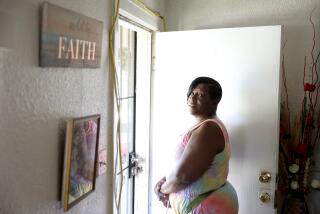First, Take Care of the Children
- Share via
People who want welfare mothers to go to work seem to forget that all welfare mothers have children. In Los Angeles, the average cost of child care for one child under 5 is $400 A month. A job that pays $6 an hour grosses $960 monthly, before taxes. Who can afford child care on that income?
I never thought I’d be on welfare. I am an articulate, intelligent, college-educated woman. I had many plans for my life. Being on welfare was not on the list. But getting there is easier than you think.
After graduation from college, I traveled widely and then began my career working for a large retail sales company. Over the next seven years, I worked in human resources departments and developed career training programs for companies.
In 1992, my life took a turn with an unplanned pregnancy. When I refused to have an abortion, my son’s father vanished. After Alex was born, I started looking for work again. I had no idea finding a job in my field would be virtually impossible. I worked as a temp and found odd jobs. A year and a half later, I was still unemployed. I had too much experience for entry-level, and too little for management. With no child support, affordable child care, or insurance, and only part-time work, I had to go on welfare. Between the cost of my son’s birth and other medical expenses, I could no longer afford private insurance and had to have MediCal.
I hated every minute. For therapy, I kept a journal. The other key to my survival was my friends at church. To get off welfare, you need lots of support.
I wanted to develop training programs, but the biggest obstacle was my lack of a track record in Southern Californa. So, I looked for organizations needing volunteer trainers. Soon I found KCET and became a volunteer. Eventually I asked to be a trainer. They said they would try me; I jumped at the opportunity and worked for free. Six months later I was leading training workshops for the Sesame Street Preschool Education Program. It was a time of extreme hardship for me. I was facing eviction and my car was stolen. I had to have child care if I was going to work. Luckily, we qualified for one year in a publicly funded child development program.
I knew there were thousands of other people who could make the transition off welfare with a little help. Welfare mothers don’t need clothing vouchers, one of the solutions Gov. Wilson has proposed. They need child care. When women have child care, every reason for not going to school, work, or for training is eliminated.
Individuals, churches, charities, businesses and government can all do something to provide child care.
First, it is not acceptable for any church to collect money from people every week and not have a single child-care option for their congregation. Churches could cover child care costs for one child for every 100 members of their congregation. A subsidy of $200 per child per month would make care affordable for most people. Churches whose congregations had few needs could help congregations with many needs.
Churches could also:
* Identify and support child care providers in your congregation.
* Start a Mommy and Me activity group. Parents can build relationships with others and start a child care support group or cooperative.
* Offer parenting classes. Teach teenagers how to babysit. They are a valuable short-term child care resource.
* Publish a local child care resource directory.
* Appoint a child care liaison to identify child care resources funded by state, federal and private agencies.
Most parents need at least six hours per day to take classes or go to work. A four-hour federal Head Start program for pre-schoolers is not enough. We could combine church-subsidized or business-subsidized child care and Head Start.
Every corporation of 100 employees or more should provide on-site child care or contribute to a nearby stand-alone facility. We all know these programs reduce absenteeism and encourage loyalty.
Combine senior and child care centers to create a new extended family structure. Seniors can find meaning in sharing their love with children. The children get more one-on-one interaction with adults.
Welfare reform is easier when everyone becomes responsible. Let’s form partnerships to provide safe, nurturing and affordable environments for our children and at the same time rebuild community relationships between government, families, churches and businesses.


